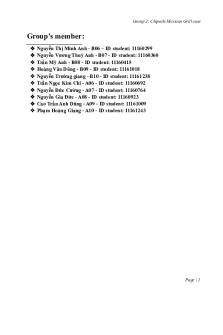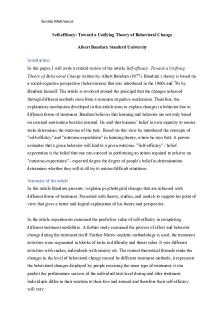IBUS2309 Individual Assignment [Graded 7- 95/100] PDF
![IBUS2309 Individual Assignment [Graded 7- 95/100]](https://pdfedu.com/img/crop/300x450/m6rm6npkd2py.jpg)
| Title | IBUS2309 Individual Assignment [Graded 7- 95/100] |
|---|---|
| Course | Managing Across Cultures |
| Institution | University of Queensland |
| Pages | 11 |
| File Size | 244.3 KB |
| File Type | |
| Total Downloads | 41 |
| Total Views | 130 |
Summary
got 95/100 for this assignment ...
Description
IBUS2309 UNDERSTANDING CULTURES IN INTERNATIONAL BUSINESS
Lecturer’s Name: Dr Andre Pekerti Registered Tutorial: T1, Friday, 11am Tutor’s Name: Mr. Kevin Zhu Word Count: 2131 (excluding reference list)
IBUS 2309: Understanding Cultures in International Business
Semester 2, 2019
Part 1: Anis is a Malaysian and also a Muslim at birth, who used to study abroad in the United States. She completed her four-year college education in Business Management at the University of Chicago and as of now filling in as a manager in one of the local companies in Malaysia. One day, she got a call from her closest companion in Chicago, Natalie, saying that he would have a conference in Malaysia and given that chance, she intended to visit Anis's home and would want to stay there for a couple of days. Anis agreed to this and welcomed Natalie to stay at her in her parent's home for two days. In preparation for Natalie’s stay, Anis's parents had arranged plenty of things to welcome her including cleaning the house thoroughly, particularly the floor. They also purchased numerous food supplies in anticipation of home-prepared Malaysian dinners they wanted to cook for Natalie. This demonstrates how much welcoming Anis’s parents were and were happy to meet Natalie.
Natalie, on the other hand, is a final-year student understudy at the University of Chicago. She is an American-conceived and was raised in a family which is considered to have middle-class income. She has never been abroad, thus, in that manner, she was eager to visit Malaysia and find the distinctions between America and Malaysia.
When Natalie arrived at Anis's home, she was welcomed by Anis herself at the main door. Anis invited Natalie to come in and asked her to sit on the couch in the living room while she
made some drinks. Anis's home is a two-story house which the first floor begins with the main entryway, the following in vision is the living room, trailed by a dining area and pathway to the kitchen. The flooring is made of tiles aside from one particular area which was covered with carpet. By the view from the living room, it was obvious that Anis’s family prioritise cleanliness as everything was carefully arranged and dust-free. While being delighted by the structure of Anis's home, Natalie came into the house without realising that Anis had removed her footwear, while Natalie did not.
Once Natalie got into the house, Anis was already gone from her view to make drinks and also went to informed her parents who were upstairs that Natalie had shown up. Following a couple of moments, Natalie heard strides originating from upstairs and expected that may be Anis's parents, Natalie had set herself up to greet them and strolled to the stairs. The moment when Anis's mother saw Natalie, she was stunned and gasped, which resulted in Natalie being baffled and speechless. Anis's mother pointed at Natalie's shoe and said "No!" to her thrice. Not understanding the situation, Natalie called for Anis. Anis at that point asked Natalie to remove her footwear and leave it outside the house. Natalie was utterly confused by that and thought, ‘What did I do wrong? Why do I have to remove my shoes?’ . She then politely refused to do so as she believed she did nothing wrong with wearing shoes inside the house.
Part 2: Assumption A Anis’s mother didn't like Natalie’s shoes. The design of Natalie’s shoes was outrageous and Anis’s mother found it very dislikeable. Thus, she did not want to have a sight on Natalie’s shoes when talking to her.
Assumption B Anis‘s mother has Obsessive-Compulsive Disorder (OCD). People with OCD tend to want everything to be in a perfect manner including being always clean. She might be shocked that Natalie wore shoes in her house especially after she has cleaned the house thoroughly. Seeing Natalie wearing shoes stepping on her ‘hard work’ seems discourteous and something to be frantic about.
Assumption C Anis’s societal culture believe that wearing shoes inside the house is rude and unhygienic. It is known to be a tradition for most people that Asian culture to not wear shoes inside their houses. Some households would provide indoor slip-on for the guest if they are uncomfortable to go barefoot. Natalie might also have stepped on the ‘praying area’ which was supposed to be clean from dirt and a sacred spot for Muslims (given that Anis and her family are all Muslims) to do their prayers. Wearing shoes inside the house not only bring the dirt from outside but also disrespect the values and norms of the host.
Assumption D Anis’s mother saw Natalie’s shoes as threatening and intimidating. She probably has a Post-Traumatic Stress Disorder (PTSD) and looking at Natalie’s shoes triggered her traumatic memory and reminded her of the incident she has experienced and she would want Natalie to get rid of it out of her sight.
Part 3: Culture is to be defined as a set of beliefs, customs, practices and convictions abide by a group of people that in a way affect their overall behaviour and actions. Culture may differ according to a particular ethnicity, race, religion and even the way of living (Mead, 2018). Thus, due to these differences, cross-cultural clashes happen in various situations either through verbal or non-verbal communication.
The incident in Part 1 explains that the particular cross-cultural incident happened due to ineffective non-verbal communication between Anis and Natalie. Anis didn't tell Natalie to remove her footwear in the first place because she assumed it is a norm for everyone and didn’t feel the need to tell Natalie. On the other hand, Natalie clearly did not find wearing shoes inside the house to be wrong and rude. To compare the differences between Anis (Malaysian) and Natalie’s (American) culture, Hofstede’s and Triandis’s cultural dimensions can be used as references. Looking from Natalie’s perspective, it is clearly that Anis practices a high-context communication dimension as she expected Natalie to do exactly as what she had done without verbally instruct her. According to Hall’s communication dimension, culture with high-context values implicit information and non-verbal communication more than verbal in such culture should be learnt through actions rather than being taught verbally (Hall, 1960; Kitler et al., 2011).
Theory founded by Geert Hofstede stated that the collectivism-individualism concept is the main key for cultural differences (Hofstede, 2011; Minkov & Hofstede, 2012). It is found that American is one of the most individualistic cultures in the world with 91 over 100 of individualism dimension score; they value individualism more than collectivism (Hofstede
Insight, 2017). In other words, they prioritise actions that benefit “I” more than it benefit “we”. Malaysian on the other hand only score 26 for individualism dimension, making them one of the lowest compared to other cultures (Hofstede Insight, 2017). The incident in Part 1 also demonstrates that these two races have different cultures and view the consequences of their hygienic practices differently. For instance, wearing shoes inside other people’s house will protect the doer’s feet from dirt but otherwise will bring dirt into the house and resulting in inconveniencing other people. Natalie might think that it is unhygienic for her to go barefoot in someone’s house, but from Anis’s perspective, Natalie wearing her shoe inside will bring dirt into the house and eventually affect everyone in the house.
One of the factors that may influence Americans to normalise wearing their shoes inside their house is the weather condition. Western countries have four seasons per year, unlike most Asian countries which mostly have experience rainy and sunny season all year long. Therefore, most homes in the United States are able to have fully carpeted flooring that protects their feet from cold and provides warmth during winter. Thus, wearing shoes inside will not affect their floor unless the shoes are very dirty. In 2016, scientists at the University of Arizona found that the normal shoe sole contained 421,000 microscopic organisms and that 90% of those microbes move straightforwardly to a spotless tile floor on the first contact (Reynolds et al., 2016).
One of the plausible reasons for Anis’ mother to be shocked seeing Natalie wearing shoes inside her house is because of her cultural belief and practice. Contrast to American’s culture, Muslim’s practices the action of removing shoes when entering indoor venue especially their houses. This is because, it is mandatory for every Muslim to pray five times a day and before
each prayer, they have to take wudu or ablution, which is an action of purifying oneself in preparation of meeting their God, Allah, and being in contact with certain dirt may cause them to lose their wudu and have to take it again (Archive.org, 2010). Therefore, being cautious of surrounding and not associating with anything that is dirty can save their time and resources. Muslims also emphasis on cleanliness at all times, especially the area where prayers are being performed (Welter & Rassool, 2016). Therefore, the action of removing shoes inside the house is to prevent filth from coming into the house that may hinder them to perform perfect prayers. In addition, not only Muslims and Malaysian but other Asian races such as Japanese, Chinese and Korean also practice the tradition of not wearing shoes inside their houses.
There is also a possibility that Anis’s mother was shocked seeing Natalie wearing shoes inside her house was because the shoes were not to her liking. It is found that one’s appearance might also affect effective communication and one acceptance towards other people. Researchers Murphy and Hildebrandt found that the appearance of a speaker and vibes of the surrounding him or her have effects on the attitudes and emotions of the spoken words and the message conveyed; clothing, hairstyles, tidiness and stature will influence the audience to form impressions of the speaker as an individual (Murphy & Hilderbrandt, 1997; Krause, 1997). Therefore, having Natalie wearing shoes that Anis’s mother dislike could create a barrier to effective communication between these two parties (Clapp-Itnyre, 1997).
Moreover, according to the study of psychological science, Obsessive-Compulsive Disorder (OCD) is a mental disorder where the patients to have unwanted, recurring thoughts or sensations of doing things (obsessions) and to satisfy them, they tend to do repetitive and
sometimes unnecessary actions also known as compulsions (Psychiatry.org, 2009). In relation to the incident, Anis mother might think that wearing shoes inside her house would bring dirt into the house and she is uncomfortable with it since she has an obsession with keeping things clean and dust-free. Therefore, resulting in her feeling disturbed just by looking at Natalie’s outdoor shoe inside her house.
In addition, the assumption of Anis’s mother having Post-traumatic Stress Disorder (PTSD) is also possible as it is a very common condition such it is found that more than 12 million American adults are diagnosed with PTSD in any given year (Kessler et al., 2012). PTSD is a mental condition where patients are unable to recover after experiencing a traumatic incident. One’s PTSD could be triggered just by looking at a physical appearance that is similar or has associations with the memory of the traumatic event. When PTSD occurs, some people would experience difficulty in breathing, feeling angry and even finds everyone irritating (Stern, 2014).
Part 4: Assumption A It is very unlikely that someone would become angry and irritated towards somebody else just because of their shoes. Although in some cases this could happen but seeing how excited Anis’s mother was when preparing her house for Natalie, it is highly unlikely that Anis’s mother would react negatively just because she dislikes one’s clothing. Any rational person would definitely act in such consideration that everyone has different preference and liking.
Assumption B Assuming someone to have a mental disorder such as OCD during fist encounter is an example of Attribution Theory where people tend to put causes to other people’s behaviour in an attempt to understand them but doing so without doing thorough research (Gordon, 2006). Even if Anis’s mother does have OCD, it is very unlikely that she would instantly react negatively towards his daughter’s guest whom she was excited to meet earlier on.
Assumption C It is very likely for the incident to happen due to the difference in cultural practice between Anis and Natalie’s cultures. There was no absolute law or rule that forbids wearing shoes inside the house but since it was what Anis and her family practices for the longest they could remember and was thought to do so by their ancestors, it was likely for them to expect their guest to do the same.
Assumption D Assuming that a person having a mental disorder like PTSD also an example of an act of Attribution Theory. There were no evidence or facts stated in Part 1 that Anis’s mother is suffering from PTSD and has fear of shoes. Even if she does, Anis would definitely tell Natalie beforehand so that it would not trigger her mother.
References Archive.org., (2010). CRCC: Center For Muslim-Jewish Engagement: Resources: Religious Texts. [online] Available at: https://web.archive.org/web/20110525070903/http://www.usc.edu/schools/college/crc c/engagement/resources/texts/muslim/hadith/bukhari/004.sbt.html [Accessed 15 Sep. 2019]. Clapp-Itnyre, A., 1997. Effective Business Communications. Business Communication Quarterly, 60(3), p.146. Gordon, L. M.; Graham, S. (2006). Attribution theory. The Encyclopedia of Human Development. 1. Thousand Oaks: Sage Publications. pp. 142–144 Hall, E., (1960). The Silent Language in Overseas Business. Harvard Business Review , 38(3), p.87. Hofstede, G., (2011). Dimensionalizing Cultures: The Hofstede Model in Context. Online Readings in Psychology and Culture, 2(1) Hofstede Insights. (2017). Country Comparison - Hofstede Insights . [online] Available at: https://www.hofstede-insights.com/country-comparison/malaysia,the-usa/ [Accessed 16 Aug. 2019] Kessler, R.C. et al., (2012). Twelve-month and lifetime prevalence and lifetime morbid risk of anxiety and mood disorders in the United States. International Journal of Methods in Psychiatric Research , 21(3), pp.169–184. Kittler, M. G., Rygl, D. and Mackinnon, A. (2011) ‘Special Review Article: Beyond culture or beyond control? Reviewing the use of Hall’s high-/low-context concept’, International Journal of Cross-Cultural Management, 11(1), pp. 63–82.
Krause, T., (1997). Book Reviews: Effective Business Communications, Seventh Edition. Herta A. Murphy, Herbert W. Hildebrandt, and Jane P. Thomas. New York: McGraw-Hill, 1997, 617 pages. Reviewed by Alisa Clapp-Itnyre Purdue University, West Lafayette, Indiana. Business Communication Quarterly , 60(3), pp.146–148 Mead, L., (2018). Cultural Difference. Society , 55(6), pp.482–487 Minkov, M., & Hofstede, G., (2012). Hofstede’s Fifth Dimension: New Evidence From the World Values Survey. Journal of Cross-Cultural Psychology, 43 (1), 3–14. Psychiatry.org., (2009). What Is Obsessive-Compulsive Disorder? [online] Available at: https://www.psychiatry.org/patients-families/ocd/what-is-obsessive-compulsive-disor der [Accessed 18 Sep. 2019]. Reynolds, K. et al., (2016). The Dynamics of Microbe Spread via Hands and Fomites Throughout an Outpatient Clinic. Open Forum Infectious Diseases , 3(suppl_1), pp.Open Forum Infectious Diseases, 12/01/2016, Vol.3(suppl_1) Stern, J., 2014. PTSD. Psychoanalytic Psychology , 31(2), pp.255–261 Welter, B., 2016. Rassool, G. Hussein (2016) Islamic Counselling: An Introduction to Theory and Practice. Journal of Pastoral Care & Counseling , 70(1), pp.103–104...
Similar Free PDFs

Individual Assignment
- 26 Pages

Individual Assignment
- 20 Pages

Individual assignment
- 5 Pages

Individual assignment
- 3 Pages

SEO Peer Graded assignment
- 1 Pages

Graded Related Rates Assignment
- 2 Pages

Practice Peer-graded Assignment
- 6 Pages

ENVS1301-Graded Quiz Unit 7
- 10 Pages

Individual Infographic Chapter 7
- 6 Pages

MGT 162 INDIVIDUAL ASSIGNMENT
- 24 Pages

finance - individual assignment
- 7 Pages
Popular Institutions
- Tinajero National High School - Annex
- Politeknik Caltex Riau
- Yokohama City University
- SGT University
- University of Al-Qadisiyah
- Divine Word College of Vigan
- Techniek College Rotterdam
- Universidade de Santiago
- Universiti Teknologi MARA Cawangan Johor Kampus Pasir Gudang
- Poltekkes Kemenkes Yogyakarta
- Baguio City National High School
- Colegio san marcos
- preparatoria uno
- Centro de Bachillerato Tecnológico Industrial y de Servicios No. 107
- Dalian Maritime University
- Quang Trung Secondary School
- Colegio Tecnológico en Informática
- Corporación Regional de Educación Superior
- Grupo CEDVA
- Dar Al Uloom University
- Centro de Estudios Preuniversitarios de la Universidad Nacional de Ingeniería
- 上智大学
- Aakash International School, Nuna Majara
- San Felipe Neri Catholic School
- Kang Chiao International School - New Taipei City
- Misamis Occidental National High School
- Institución Educativa Escuela Normal Juan Ladrilleros
- Kolehiyo ng Pantukan
- Batanes State College
- Instituto Continental
- Sekolah Menengah Kejuruan Kesehatan Kaltara (Tarakan)
- Colegio de La Inmaculada Concepcion - Cebu
![IBUS2309 Individual Assignment [Graded 7- 95/100]](https://pdfedu.com/img/crop/172x258/m6rm6npkd2py.jpg)



